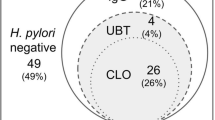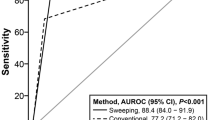Abstract
The aim of the present study was to compare the gastric juice ammonia test to the CLO test for the diagnosis ofH. pylori infection in culture-proven cases by receiver operating characteristic (ROC) curve analysis. We studied 75 subjects (44 with chronic gastritis, 10 with gastric ulcer, 6 with duodenal ulcer, 8 with gastric cancer, and 7 normal) by endoscopy with biopsy for tissue diagnosis, culture ofH. pylori. CLO test, and by gastric juice ammonia determinations. The culture-positive group had significantly higher intragastric ammonia levels (13.7±5.8 mg/dl) than the negative group (4.9±2.4 mg/dl,P<0.01). In ROC curve analysis, the gastric juice ammonia test showed higher true positive and lower false positive ratios than the CLO test (P<0.05). In conclusion, the measurement of intragastric juice ammonia levels was considered to be simpler, quicker, and overall a more valuable method for diagnosingH. pylori infection.
Similar content being viewed by others
References
Brown KE. Peura DA: Diagnosis ofHelicobacter pylori infection. Gastroenterol Clin North Am 22:105–115, 1993
Goodwin CS, Blincow ED, Warren JR, Waters TE, Sanderson CR, Easton L: Evaluation of cultural techniques for isolatingCampylobacter pyloridis from endoscopic biopsies of gastric mucosa. J Clin Pathol 38:1127–1131, 1985
Peterson WL, Lee EL, Feldman M: Relationship betweenCampylobacter pylori and gastritis in healthy humans after placebo or indomethacin. Gastroenterology 96:1185–1197, 1986
Tsuchihashi K, Imoto I, Shibata T, Takaji S, Ikamura N, Taguchi Y, Shida Y, Hasagawa H, Yoshida M, Fukukita S, Suzuki S: Usefulness of measuring intragastric ammonia levels as a screening method for the diagnosis ofHelicobacter pylori infection. Jpn J Gastroenterol Endoscopy 35:253–260, 1993
Henley JA. McNeil BJ: A Method of comparing the areas under receiver operating characteristic curves derived from the same cases. Radiology 148:820–841, 1983
Geodwin CS, Armstrong JA, Marshall BJ:Campylobacter pyloridis, gastritis and peptic ulceration. J Clin Pathol 39:353–365, 1996
Hazell SL, Hennessy WB, Borody TJ, Carrick J, Ralston M, Brady L, Lee A:Campylobacter pyloridis gastritis: Distribution of bacteria and associated inflammation in the gastroduodenal environment. Am J Gastroenterol 82:297–301, 1987
Morris A, Ali MR, Brown P, Lane M, Patton K:Campylobacter pylori infection in biopsy specimens of gastric antrum: Laboratory diagnosis and estimation of sampling error. J Clin Pathol 42:727–732, 1989
Wyatt JI, Primross J, Dixon MF: Distribution ofCampylobacter pylori in gastric biopsies. J Pathol 185:360A, 1988
Langenberg ML, Tytgat GNJ, Schipper MEI, Rietra PJGM, Zanan HC:Campylobacter-like organisms in the stomach of patients and healthy individuals. Lancet 1:1348, 1984
McNulty CMA, Wies R: Rapid diagnosis ofCampylobacter-associated gastritis. Lancet 1:1443–1444, 1985
Thillainayagan AV, Arivnd AS, Cook RS, Harrison IG, Tabaqchalis, Farthing MJG: Diagnostic efficiency of an ultrarapid endoscopy room test forHelicobacter pylori. Gut 32:467–489, 1991
Graham DY, Klein PD, Evans DJ Jr, Evans DG, Alpert LC, Opekun AR, Boutton TW:Campylobacter pylori detected noninvasively by the13C-urea breath test. Lancet 1:1174–1177, 1987
Marshall BJ, Surveyor I: Carbon-14 urea breath test for the diagnosis ofCampylobacter pylori associated gastritis. J Nucl Med 29:11–16, 1986
Mossberg SM, Thayer WR Jr, Spiro HM: Azotaemia and gastric acidity: The effect of intravenous urea on gastric acid and gastric ammonium production in man. J Lab Clin Med 61:469–475, 1983
Chittajallu RS, Neithercut WD, Macdonald AMI, McColl KEL: Effect of increasingHelicobacter pylori ammonia production by urea infusion on plasma gastrin concentrations. Gut 32:21–24, 1991
Author information
Authors and Affiliations
Rights and permissions
About this article
Cite this article
Yang, D.H., Bom, H.S., Joo, Y.E. et al. Gastric juice ammonia vs CLO test for diagnosis ofHelicobacter pylori infection. Digest Dis Sci 40, 1083–1086 (1995). https://doi.org/10.1007/BF02064203
Received:
Revised:
Accepted:
Issue Date:
DOI: https://doi.org/10.1007/BF02064203




